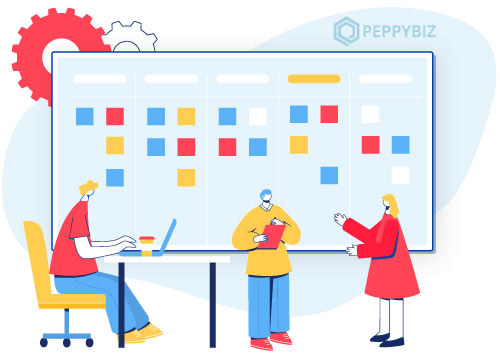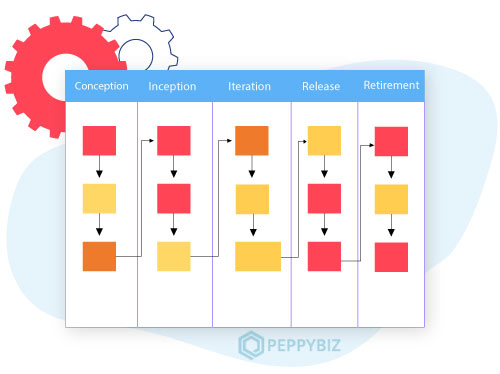Agile Workflow | A Simple Guide to Create and Implement
To cope up with the modernizing world it is very crucial to become adaptive to the changes. Agile Workflow is a new and modified version of workflow that is implemented in several software projects. It is made to increase the efficiency and profits of a software company. A huge software project is broken down into smaller tasks and assigned to every individual of the team.
Not on the team, but customers also play a huge role in Agile Workflow. The software company takes feedback from their customer and constructively works on them to give the best results. This not only attracts new customers but also promises to hold the old customers.
Software Companies that adopt agile workflow develop a good speed, higher success rate, expand collaborations, and respond to change in the market dynamics. Its main purpose is to satisfy customer needs, and the way to get it done is commendable.
Before digging into the guide to create and implement agile workflow, let’s learn about the 4 key elements of Agile methodology:
4 Key Elements Of Agile Methodology Are:
1) 5 key agile principles
It is very important to read and understand the keywords that are used in the process of Agile Workflow.
- Customers should be included in the loop of Agile Workflow. Taking feedback from customers and working on them plays a huge role.
- The software company needs to gulp in this fact that no matter how much they have worked on the product. If change is required from the customer’s end, they have to get it done. This can be grinding and frustrating, but customer satisfaction is the ultimate goal.
- The software should be delivered to the customers after the completion of every sprint as customers will be able to tell the modifications required only after using the product.
- The team should be very active and adaptive to changes. A peaceful and cheerful environment plays a huge role in this. Making constant changes to the same product will take a lot of energy and patience.
- The team should be dedicated to the company and the product. It takes a huge amount of time and expertise for teammates to develop such products.
2) Product Backlog

Product Backlog is created before starting an Agile Workflow. In Product Backlog, all the tasks and ideas that will be used in developing the product are mentioned. As soon as an idea arrives, it is written in the product backlog, and over time it gets organized.
As customers will start providing the reviews, the process and ideas will be eliminated and organized accordingly. The backlog products should be well defined, tightly scoped, and prioritized.
3) Sprints
Sprints are the smaller tasks that together make the whole project plays an important role in Agile Workflow. Constructive feedback is taken from the customers after the completion of every sprint. This gives a fair chance to the software company to make a change in the desired software there and then only. So modifications are done on that particular sprint before moving to the next sprint. This process actively involves customers at every step of the software development that eventually increases the buy rate of that software.
4) Agile Meetings

Scheduling daily meets play a major role in the development of the product. Taking updates from the team and solving the problems they are facing is an essential part.
Two types of meetings named daily standups and sprint retrospectives are part of agile meetings. In daily standups, the progress of the product is discussed. The amount of work that has been done and will be further done is discussed in daily standups. Sprint retrospective takes place only when one sprint is completed. In this meeting, the sprint is reviewed, and required changes are discussed.
The Agile Workflow procedure

This is similar for all kinds of products that are developed. We will be discussing software product development here.
The cycle of software development includes the following steps:
- Conception – The planning of projects is done at this phase. Product backlogs and sprint planning tools gets started.
- Inception – At this phase, teams are divided based on the sprints. Work is assigned to members of every sprint. The working environment and resources required to develop the project are also discussed in this phase.
- Iteration – Teams start working according to the sprints assigned. The product backlogs are also modified at this phase.
- Release – The product is sent to the customer at this phase. The customers review the product and give feedback. The team works on that sprint, makes changes according to the customers’ requirement, and then moves to the next sprint.
- Retirement – It is the end of the workflow when the product is developed.
It is very important to break down the sprint development into different cycles as they play a major role in product development. So, let’s talk about the development of the sprint cycle :
- Requirements – it is important to get all the resources required to develop that particular sprint.
- Development – at this stage of the cycle, the particular sprint is developed by the teammates.
- Testing – this stage is very important as testing of the sprint tells about the arising problems.
- Delivery – the product made out from the particular sprint is delivered to the customers to review the product and send feedback.
- Feedback – Acceptance of feedback from the stakeholders and customers is done at this stage. Then the teams start working on those feedbacks to deliver the product based on the customers’ requirements.
Guide to Create and Implement Agile Workflow
The software company needs to follow 4 important steps:
1. Forming – The team leader needs to explain every step of agile workflow to the team clearly. The team needs to understand the essence of this flow. This will help them to conceptualize the workflow they will be going through.
2. Storming – At this phase, the team starts working on dividing the sprints. As they are going to execute the project, the division should be done by them. Make the deadlines of the sprints as practical as possible. By this method, the role of every individual on the team will also be clarified.
3. Norming – Assignment of roles is done in this phase. Explain the job description of the specific sprint assigned to a specific team. Various job designations such as project stakeholders, owners, and managers are decided. The product owner will be responsible for taking feedback from customers and will share it with the team. Stakeholders are senior managers, marketers, and salespeople who are not involved in the project but play a vital role.
4. Performing – This is the last and ultimate phase of agile workflow. The team starts working on the sprint assigned to them. Daily updates should be taken to make changes required in the project. As soon as the team does changes required and suggested by the customers, review it and move to the next sprint.
Conclusion
The implementation of the agile workflow is very easy only when the project’s plan is laid properly. The process seems to be quite lengthy, but it’s very easy if done properly. Just follow every step of the creation with dedication, and the outcome won’t disappoint you.



